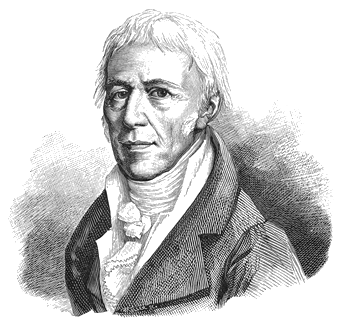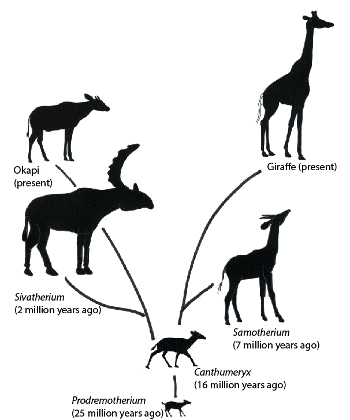The Giraffe Neck
November 23, 2015
Ancient people were interested in the
nature of
animals and
plants, since their livelihood depended on them, but their observations were not the
systematic scientific observations we make today. As an example,
Aristotle (384 BC-322 BC), in his
History of Animals, writes that "
Males have more
teeth than
females in the case of
men,
sheep,
goats, and
swine."[1] Perhaps tooth counting of the
opposite sex was considered
impolite in
ancient Greece, but a few minutes of observation would have invalidated this statement.
Ancient people had a "
logical" view of the
diversity of animal
species. Although they didn't know anything about
DNA and
genetics, they realized that
environment shapes the particular structure of
organisms. However, such
folk knowledge could often be wrong, as illustrated in an episode of
Star Trek: The Next Generation.
In that episode,
Thine Own Self (Season 7, Episode 16), the
android,
Data, is stranded as an
amnesiac on a
planet having a
civilization much like
Earth's Middle Ages. Data's pale appearance is explained by the
conjecture that he came from the
ice-covered Vellorian Mountains. The reasoning is that since humans pale upon exposure to cold, then a race of humans living in the cold would naturally become pale over the course of
generations.
Such thinking appears in the
theories of
French naturalist,
Jean-Baptiste Lamarck (1744-1829),
author of
Système des animaux sans vertèbres, a classification of
invertebrates published in 1801. His major contributions to
biology notwithstanding, Lamarck is much maligned for his belief in the
inheritance of acquired characteristics.

An 1893 Portrait of Jean-Baptiste Lamarck (1744-1829) by Jules Pizzetta (1820–1900).
(Via Wikimedia Commons.)
The theory of adaptation, now known as
Lamarckism, claimed that
physiological changes of an animal would be transmitted to its offspring. This idea was earlier conjectured in the writings of
Hippocrates and Aristotle. Lamarckism, informed by
fossil evidence, had more
scientific backing than the opinions of ancient
philosophers. The usual example of Lamarckism is the long
neck of the
giraffe.
According to Lamarck, giraffes started with shorter necks, and their stretching to eat
tree leaves resulted in their offspring having slightly longer necks. Going through many generations of this resulted in the giraffe that we see today. Some Lamarckist ideas persisted in the
mid-20th century in the
Soviet Union, where
Trofim Lysenko, president of the
Soviet Academy of Agricultural Sciences, would add
sugar to the
irrigating water of
fruit trees to develop trees with sweeter
fruit.
Charles Darwin believed that the advantage of a long neck for feeding caused an
evolutionary advantage that propagated to offspring in the usual Darwinian sense by
natural selection. As Darwin wrote in 1872 in the sixth edition of his
Origin of Species,
"The giraffe, by its lofty stature, much elongated neck, fore legs, head and tongue, has its whole frame beautifully adapted for browsing on the higher branches of trees. It can thus obtain food beyond the reach of the other Ungulata or hoofed animals inhabiting the same country; and this must be a great advantage to it during dearths... So under nature with the nascent giraffe, the individuals which were the highest browsers and were able during dearths to reach even an inch or two above the others, will often have been preserved... those individuals which had some one part or several parts of their bodies rather more elongated than usual, would generally have survived. These will have intercrossed and left offspring, either inheriting the same bodily peculiarities, or with a tendency to vary again in the same manner; while the individuals less favoured in the same respects will have been the most liable to perish."[2]
Such a form of natural selection is far slower than selection directly involving
sexual attributes,
one example of which is the
peacock's feathers. This idea is such common knowledge that the Star Trek
Ferengi were shown to have evolved large
ears, since they are
erogenous zones. In the category of "size matters,"
behavioral studies of giraffes show that the male giraffes with the longest necks are the ones who mate and pass their genes to future generations since they are used in
fighting for dominance in a behavior called "necking." The reason for neck lengthening may arise from both the
foraging and necking behaviors.
Now that we understand the "why" of the giraffe's long neck,
scientists from the
New York Institute of Technology have focused on the "how." In a recent
paper in the
journal,
Royal Society Open Science, the
research team looked at the
fossil record of
cervical vertebrae of the giraffe family and related species, and they found that the evolution of the
bone structure leading to the elongation likely occurred in several stages.[3-4] The animal's neck vertebrae first stretched toward the
head, and there was a second stretching a few million years later toward the
tail.[3-4]
Explains New York Institute of Technology giraffe
anatomy expert and
paleontologist,
Nikos Solounias,
"It's interesting to note that that the lengthening was not consistent... First, only the front portion of the C3 vertebra lengthened in one group of species. The second stage was the elongation of the back portion of the C3 neck vertebra. The modern giraffe is the only species that underwent both stages, which is why it has a remarkably long neck."[4]

Left image, the fossil third cervical vertebrae (C3) of a Samotherium, an extinct giraffe species extant about 7 million years ago. Right image, the third cervical vertebrae of the modern giraffe. The Samotherium exhibits the first stage of elongation, while the modern giraffe shows both the first and second stages responsible for its elongated neck.(Left image and right image by Nikos Solounias of the New York Institute of Technology.)
Solounias and coauthor, Melinda Danowitz, studied 71 fossils of nine
extinct and two living species in the giraffe family. This was a major undertaking, since these fossils, collected from the late
19th century and early 20th century, were housed at
museums in such places as
Austria,
England,
Germany,
Greece,
Kenya, and
Sweden.[4] They made many measurements of the vertebrae and organized the data in a
computer model that tracked the evolutionary elongation.[4]
It was found that there was a stretching of the
cranial end of the vertebrae about seven million years ago in the extinct species, Samotherium, which is closely related to the modern giraffe. There was a second elongation only a million years ago at the
caudal portion (back-facing) of the vertebrae. As a consequence of these two elongations, the C3 vertebra of the modern giraffe is nine times longer than its width, so it's more than a
foot long.[4]

Neck lengthening and shortening in the giraffe family.
Longer necks evolved on the right, while shorter necks evolved on the left. Both branches evolved from the common ancestor, Prodremotherium, about 25 million years ago.
(Illustration by Nikos Solounias and Melinda Danowitz of the New York Institute of Technology.)
As shown in the figure above, there was both neck lengthening and shortening in the evolution from a Prodremotherium
common ancestor, about 25 million years ago. The only extant member of the short neck side of the giraffe family is the
okapi.[4] Now that they've researched the giraffe neck, the team intends to study the evolution of the giraffe's long
leg bones.[4]
References:
- Aristotle, "The History of Animals," D'Arcy Wentworth Thompson, Trans., Book II, Part 3, via MIT Classics.
- Charles Darwin, "On the Origin of Species By Means of Natural Selection," Project Gutenberg, John Murray (London, 1872), Sixth Edition.
- Melinda Danowitz, Aleksandr Vasilyev, Victoria Kortlandt, Nikos Solounias, "Fossil evidence and stages of elongation of the Giraffa camelopardalis neck," Royal Society Open Science (October 7, 2015), DOI: 10.1098/rsos.150393. This is an open access article with a PDF file available here.
- Researchers discover clues on how giraffe neck evolved, New York Institute of Technology Press Release, October 6, 2015.
- Melinda Danowitz and Nikos Solounias, "The Cervical Osteology of Okapia johnstoni and Giraffa camelopardalis," PLoS ONE, vol. 10, no. 8 (August 24, 2015), Document No. e0136552, DOI: 10.1371/journal.pone.0136552.
Permanent Link to this article
Linked Keywords: Ancient history; ancient people; biology; nature; animal; plant; systematic; scientific; Aristotle (384 BC-322 BC); History of Animals; male; tooth; teeth; female; human; men; sheep; goat; domestic pig; swine; gender; opposite sex; politeness; impolite; ancient Greece; logic; logical; biodiversity; species; DNA; genetics; environment; organism; folklore; folk knowledge; Star Trek: The Next Generation; Thine Own Self; android; Data; amnesia; amnesiac; planet; civilization; Earth's Middle Ages; conjecture; ice-covered; generation; theory; French; natural history; naturalist; Jean-Baptiste Lamarck (1744-1829); author; invertebrate; biology; inheritance of acquired characteristics; Jules Pizzetta (1820–1900); Wikimedia Commons; Lamarckism; physiology; physiological; Hippocrates; fossil; philosopher; neck; giraffe; tree leaf; mid-20th century; Soviet Union; Trofim Lysenko; Soviet Academy of Agricultural Sciences; sugar; irrigation; irrigating water; fruit tree; fruit; Charles Darwin; evolution; evolutionary advantage; natural selection; On the Origin of Species; sexual attribute; peafowl; peacock; Ferengi; ear; erogenous zones; behavior; dominance hierarchy; foraging; scientist; New York Institute of Technology; academic publishing; pape; scientific journal; Royal Society Open Science; research; fossil record; cervical vertebra; bone; head; tail; anatomy; paleontologist; Nikos Solounias; extinction; extinct; 19th century; museum; Austria; England; Germany; Greece; Kenya; Sweden; computer model; skull; cranial; caudal; foot; family; common descent; common ancestor; okapi; leg.